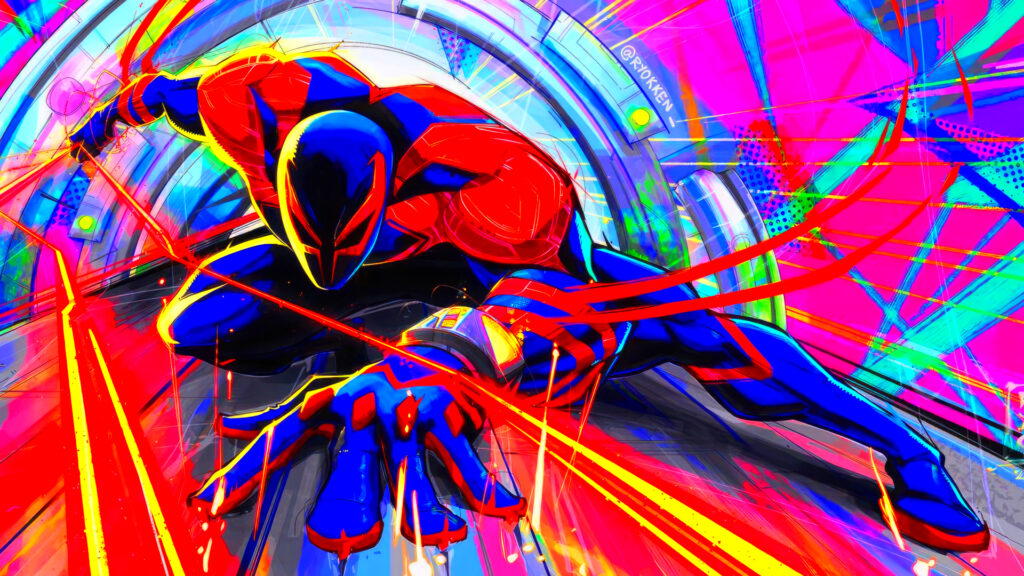The Evolution of Spider-Man in Marvel Comics

Introduction The Evolution of Spider-Man
Spider-Man, one of the most iconic superheroes in the world, has been swinging through the pages of Marvel Comics for over six decades. Created by writer Stan Lee and artist Steve Ditko, Spider-Man made his debut in Amazing Fantasy #15 in 1962, capturing the hearts of readers with his relatable struggles and witty banter. Since then, Spider-Man has undergone a remarkable evolution, both in terms of character development and narrative arcs. In this article, we will explore the fascinating journey of Spider-Man in Marvel Comics, from his humble beginnings to becoming a beloved symbol of heroism and inspiration.
The Birth of a Hero – The Evolution of Spider-Man
When Peter Parker, a shy high school student, was bitten by a radioactive spider, he gained incredible powers. As Spider-Man, he embarked on a mission to fight crime and protect the innocent. Lee and Ditko’s creation stood out from other superheroes at the time because Peter Parker was an ordinary teenager, struggling with everyday issues like school, relationships, and self-doubt. This relatability struck a chord with readers, and Spider-Man quickly became a breakout sensation.
The Iconic Rogues’ Gallery
No superhero is complete without a rogues’ gallery, and Spider-Man boasts one of the most memorable in comic book history. From his first encounter with the enigmatic Vulture to his ongoing battles with Green Goblin, Doctor Octopus, and Venom, Spider-Man has faced a diverse range of villains, each with their own motivations and unique powers. These antagonists have not only tested Spider-Man’s physical abilities but also challenged his morality and personal beliefs.
Expanding the Spider-Verse The Evolution of Spider-Man
As Spider-Man’s popularity grew, Marvel introduced alternate versions of the character to explore different dimensions and timelines. One such iteration is the futuristic Spider-Man 2099, Miguel O’Hara, who debuted in 1992. Another notable addition is Spider-Gwen, Gwen Stacy from an alternate universe, who became Spider-Woman in her reality. Marvel’s creative approach to expanding the Spider-Verse allowed for fresh storytelling opportunities, offering readers a glimpse into the multiverse of Spider-Men and Spider-Women.
Mature Storytelling and Personal Growth
In the late 1980s and early 1990s, Marvel decided to tackle more mature themes and delve deeper into Peter Parker’s personal struggles. The storyline “The Death of Jean DeWolff” explored issues of morality and justice, while “The Night Gwen Stacy Died” marked a pivotal moment in Spider-Man’s life. Moreover, the critically acclaimed “Kraven’s Last Hunt” examined the psychological toll of being a superhero. These storylines showcased Spider-Man’s growth, as he grappled with loss, guilt, and the consequences of his actions.
Miles Morales: A New Spider-Man
In 2011, Marvel introduced Miles Morales, an Afro-Latino teenager who assumed the mantle of Spider-Man after the death of Peter Parker in the Ultimate Marvel universe. Morales offered a fresh perspective on the character, tackling issues of identity and diversity. His popularity soared, and he eventually made his way into the main Marvel Universe, becoming a beloved addition to the Spider-Man mythos.
Adaptations and Influence
Spider-Man’s impact extends beyond the comic book pages. From animated series to blockbuster movies, the web-slinger has enjoyed tremendous success in various media adaptations. The 2002 film “Spider-Man,” directed by Sam Raimi, kicked off a new era of superhero films. Subsequent adaptations, including the Marvel Cinematic Universe’s portrayal of Spider-Man, have further cemented the character’s cultural significance.
Spider-Man in the MCU: The Spectacular Journey of Peter Parker
Since his debut in the Marvel Cinematic Universe (MCU) in 2016, Spider-Man has swung into our hearts as one of the most beloved superheroes of all time. Played by the talented Tom Holland, the character has undergone a spectacular journey, capturing the essence of Peter Parker’s struggles and victories while seamlessly integrating into the expansive MCU. In this article, we delve into the remarkable evolution of Spider-Man in the MCU, exploring his standout moments, his relationships with other characters, and his impact on the franchise as a whole.
1. A Fresh Start: Spider-Man’s Introduction in the MCU
Spider-Man’s inclusion in the MCU was a landmark moment for Marvel fans worldwide. After Sony and Marvel Studios reached an agreement to share the character’s rights, Spider-Man made his highly anticipated debut in “Captain America: Civil War” (2016). Tom Holland’s portrayal immediately resonated with audiences, capturing the youthful energy, wit, and relatability of Peter Parker.
2. Homecoming and Far From Home: A Hero’s Journey
Following his impressive introduction, Spider-Man took center stage in his standalone films, “Spider-Man: Homecoming” (2017) and its sequel, “Spider-Man: Far From Home” (2019). These movies allowed the character to explore the complexities of being a teenage superhero, balancing high school life with the responsibilities that come with great power.
In “Homecoming,” Peter Parker navigates the challenges of being a young hero under the guidance of Tony Stark (Iron Man), played by Robert Downey Jr. The film not only showcases Spider-Man’s agile abilities and sense of humor but also establishes his deep connection to the MCU. Michael Keaton’s Vulture serves as a formidable antagonist, providing an exciting and personal conflict for our friendly neighborhood hero.
“Far From Home” takes Peter Parker on a globetrotting adventure, dealing with the aftermath of “Avengers: Endgame.” Jake Gyllenhaal’s Mysterio brings a fresh and captivating dynamic to the film, challenging Peter’s perception of heroism and trust. Both movies expertly blend superhero action with heartfelt character moments, solidifying Spider-Man’s place within the MCU.
3. Spider-Man’s Role in the Larger MCU
Spider-Man’s presence in the MCU extends beyond his standalone films. His appearances in “Avengers: Infinity War” (2018) and “Avengers: Endgame” (2019) showcased his growth as a hero and his invaluable contributions to the epic battles against Thanos. These team-up movies emphasized the interconnectedness of the MCU and highlighted the seamless integration of Spider-Man into the larger narrative.
Moreover, the mentorship dynamic between Peter Parker and Tony Stark provided a compelling throughline across multiple films. Tony’s guidance and eventual passing of the mantle to Peter in “Endgame” reinforced the importance of legacy and the responsibility that comes with being a hero.
4. Spider-Man: No Way Home – The Multiverse Unleashed
The upcoming film, “Spider-Man: No Way Home,” promises to be a game-changer for the MCU and for Spider-Man himself. The movie is set to explore the multiverse, bringing together various iterations of Spider-Man from different cinematic universes. With the inclusion of villains like Alfred Molina’s Doctor Octopus and Jamie Foxx’s Electro, the film teases an ambitious storyline that will undoubtedly have significant ramifications for the MCU moving forward.
5. Tom Holland’s Remarkable Portrayal
Tom Holland’s portrayal of Spider-Man has been widely praised for its authenticity and charisma. He captures the essence of Peter Parker’s vulnerability, determination, and quick-witted nature, endearing himself to audiences of all ages. Holland’s youthful energy and chemistry with other actors have contributed to the success of the character, solidifying Spider-Man’s place as a core member of the MCU.
Spider-Man’s inclusion in the Marvel Cinematic Universe has been a tremendous success, reinvigorating the character and providing fans with compelling stories and unforgettable moments. From his debut in “Civil War” to his upcoming adventure in “No Way Home,” Spider-Man’s journey in the MCU has showcased the hero’s growth, his relationships, and his impact on the larger narrative.
Tom Holland’s portrayal has become iconic, capturing the essence of Peter Parker and ensuring that Spider-Man continues to swing into our hearts for years to come. As fans eagerly anticipate the next chapter of Spider-Man’s story, it’s clear that his presence in the MCU will continue to shape the franchise and captivate audiences worldwide.
Conclusion The Evolution of Spider-Man
Spider-Man’s evolution in Marvel Comics is a testament to the enduring appeal of the character. From his relatable origins to the exploration of complex themes and the introduction of new heroes, Spider-Man’s journey continues to captivate readers. As the Marvel Universe expands and new stories unfold, it is certain that Spider-Man will remain a beloved symbol of courage, resilience, and the indomitable human spirit.
In six decades, Spider-Man has swung his way into the hearts of millions, and his legacy as a timeless superhero shows no signs of slowing down.
The Evolution of #spiderman in #marvelcomics
Follow us for New Content Daily
Web – www.epicheroes.com
Twitter @epicheroes
Insta @epicheroesuk
http://www.youtube.com/c/Epicheroes
https://amazon.co.uk/shop/epicheroes
 Epic Heroes Entertainment Movies Toys TV Video Games News Art Pop culture news goodness
Epic Heroes Entertainment Movies Toys TV Video Games News Art Pop culture news goodness


